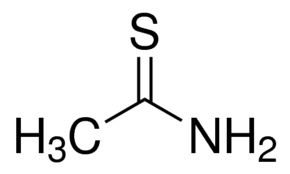Formula C2H5NS Melting point 115 °C | Molar mass 75.13 g/mol Density 1.27 g/cm³ | |
 | ||
Related compounds Appearance cristalls colourless crystals | ||
Thioacetamide is an organosulfur compound with the formula C2H5NS. This white crystalline solid is soluble in water and serves as a source of sulfide ions in the synthesis of organic and inorganic compounds. It is a prototypical thioamide.
Contents
Coordination chemistry
Thioacetamide was widely used in classical qualitative inorganic analysis as an in situ source for sulfide ions. Thus, treatment of aqueous solutions of many metal cations to a solution of thioacetamide affords the corresponding metal sulfide:
M2+ + CH3C(S)NH2 + H2O → MS + CH3C(O)NH2 + 2 H+ (M = Ni, Pb, Cd, Hg)Related precipitations occur for sources of soft trivalent cations (As3+, Sb3+, Bi3+) and monovalent cations (Ag+, Cu+).
Preparation
Thioacetamide is prepared by treating acetamide with phosphorus pentasulfide as shown in the following idealized reaction:
CH3C(O)NH2 + 1/4 P4S10 → CH3C(S)NH2 + 1/4 P4S6O4Structure
The C2NH2S portion of the molecule is planar; the C-S and C-N distances are 1.713 and 1.324 Å, both indicating multiple bonding.
Safety
Thioacetamide is carcinogen class 2B. It is known to produce marked hepatotoxicity in exposed animals. Toxicity values are 301 mg/kg in rats (LD50, oral administration), 300 mg/kg in mice (LD50, intraperitoneal administration). This is evidenced by enzymatic changes, which include elevation in the levels of serum alanine transaminase, aspartate transaminase and aspartic acid.
